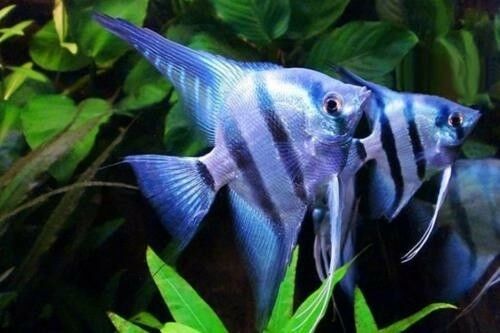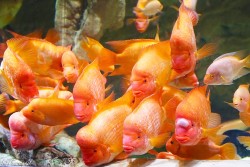Pterophyllum cichlid the King of the Aquarium

Pterophyllum Cichlids - The Graceful Angelfish
Pterophyllum is a genus of freshwater cichlids native to the Amazon River basin in South America. The species are commonly referred to as angelfish due to their tall, laterally compressed bodies and large, flowing fins that resemble an angel's wings. They have long been prized additions for aquariums.
There are three recognized Pterophyllum species - the scalare, altum, and leopoldi angelfish. P. scalare is the most widespread and frequently kept species, noted for its color variations including silver, black, gold, and marbled patterns. The altum and leopoldi angelfish are found in more limited range.
In the wild, Pterophyllum inhabit slow-moving tributaries, streams, and floodplain lakes typically surrounded by vegetation. They tend to stick close to submerged branches and roots. Angelfish feed on small crustaceans, insect larvae, and other invertebrates.
These elegant cichlids do well in planted community tanks 20 gallons or larger. While generally peaceful, they may eat very small fish. Spawning pairs are slightly territorial but make excellent parents. Providing live and frozen foods brings out their brilliance. The graceful beauty of Pterophyllum captivates aquarium enthusiasts worldwide.

FAQ's
What is a Pterophyllum cichlid, and what are its common names?
Pterophyllum cichlids, often referred to as Angelfish or Freshwater Angelfish, are graceful and popular aquarium fish known for their distinctive triangular shape and vibrant colors. They are a beloved choice among aquarists.
What are the key characteristics of Pterophyllum cichlids?
Pterophyllum cichlids are recognized for their laterally compressed bodies, elongated fins, and striking coloration. They have a unique appearance with long, trailing dorsal and anal fins. Their coloration can vary, featuring shades of silver, black, and marbled patterns.
What is the native habitat of Pterophyllum cichlids?
Pterophyllum cichlids are native to the Amazon River basin in South America. They inhabit slow-moving or still waters, such as river tributaries, lagoons, and flooded forests.
What is the recommended tank setup for Pterophyllum cichlids?
A well-decorated aquarium with tall plants, driftwood, and hiding spots is ideal for Pterophyllum cichlids. They prefer a tank with a height of at least 18 inches (45 cm) to accommodate their tall fins. A tank size of 20 gallons or more is suitable for a pair.
What water parameters do Pterophyllum cichlids prefer?
Maintain water conditions with a pH level between 6.0 and 7.5, a water hardness (dH) of 5-12, and a temperature range of 75-82°F (24-28°C) for their well-being.
What do Pterophyllum cichlids eat?
Pterophyllum cichlids are omnivorous and accept a varied diet. They can be fed high-quality flakes or pellets designed for cichlids, as well as live or frozen foods such as brine shrimp, bloodworms, and small insects.
Can Pterophyllum cichlids be kept in a community tank?
Pterophyllum cichlids can be kept in a community tank with other peaceful fish species that are not overly aggressive or fin-nipping. However, avoid housing them with very small or aggressive tankmates.
How do you breed Pterophyllum cichlids?
Breeding Pterophyllum cichlids is often initiated by a pair forming a strong bond. Provide a flat surface, such as a broad leaf or a specially designed breeding cone, for them to lay their eggs. The parents will guard and care for the fry.
Are Pterophyllum cichlids suitable for beginners in the aquarium hobby?
Yes, Pterophyllum cichlids are considered suitable for beginners due to their adaptability and relatively simple care requirements. They are an excellent choice for aquarists looking to venture into keeping cichlids.
Are there any specific health concerns for Pterophyllum cichlids?
Pterophyllum cichlids can be susceptible to common fish diseases. Maintaining good water quality, a balanced diet, and regular monitoring are essential for their health and well-being.



